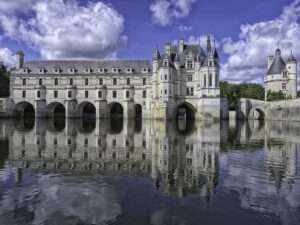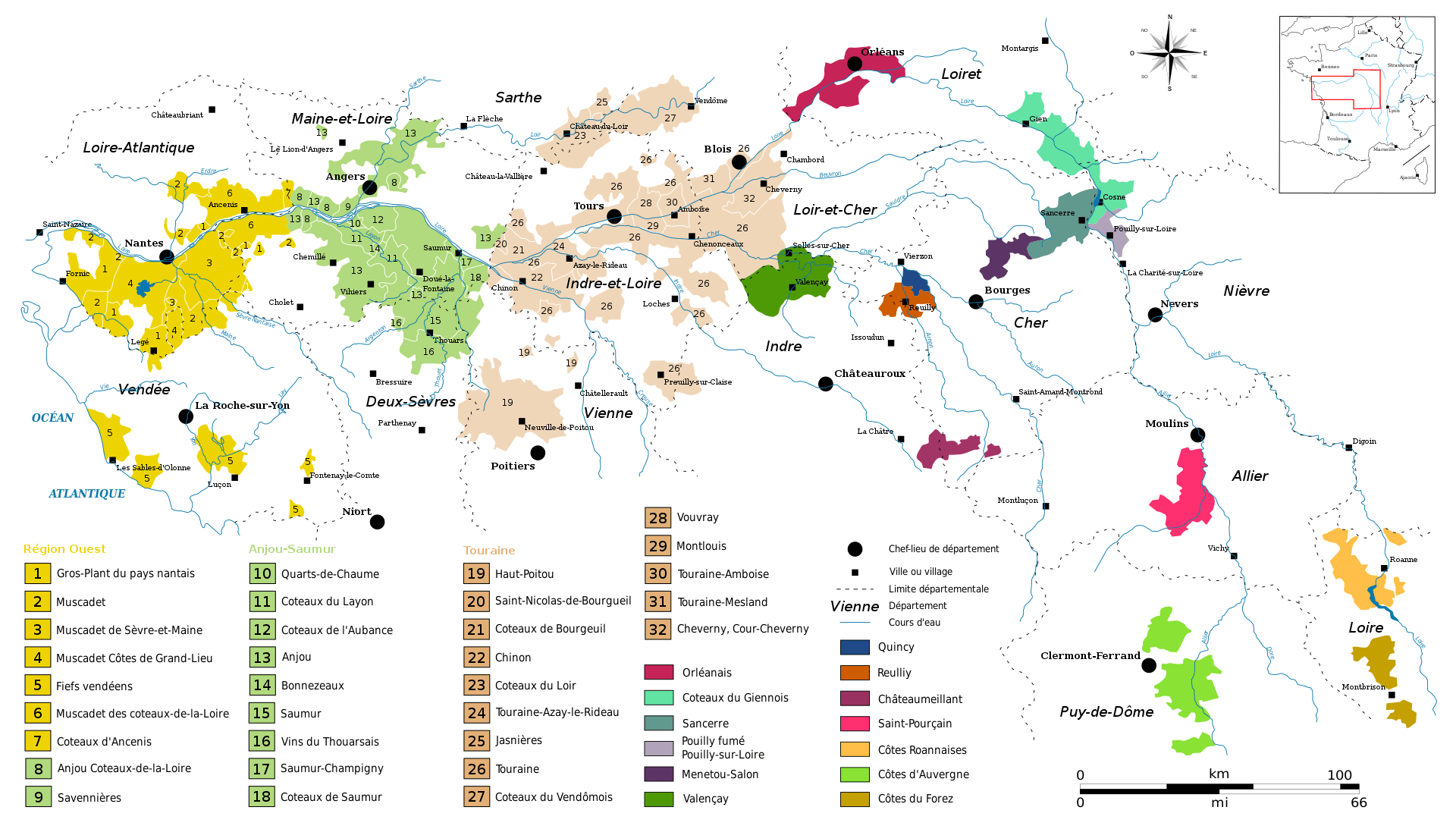A Journey Through France’s Cultural Heartland
Exploring the picturesque journey from Paris to the Loire Valley is like stepping into a storybook. This captivating route takes you from the bustling streets of Paris to the serene landscapes and majestic châteaux of the Loire Valley. Whether you’re a history enthusiast, a wine connoisseur, or simply a traveler in search of beauty, this route has something for everyone.
Bespoke Tour from Paris to Loire Valley
PARIS BY EMY as a Paris Travel Planner offers tailor-made tours. Each client is unique. In that sense, your tour is fully customized (cities, castles, lunch break, itinerary…) and not already-made.
Your driver will never be your guide while driving you in Loire Valley, for safety reasons first. Driver distractions are the leading cause of most vehicle crashes. Thus, having both a private driver AND a private guide allows the driver to pay fully attention on his driving tasks.
However, for budget friendly and clients who need independance, PARIS BY EMY offers bespoke Tour from Paris to Loire Valley with a private driver ONLY and a personalized travel itinerary.
Paris Private Car Service
| Pricing | Duration | Features | Location | Passengers |
|---|---|---|---|---|
| From 580 € | 4 hours | Driver only | Paris | 1 to 7 |
| From 850 € | 4 hours | Guide+driver | Paris | 1 to 6 |
| From 1,180 € | 6 hours | Guide+driver | Paris | 1 to 6 |
| From 1,400 € | 8 hours | Guide+driver | Champagne | 1 to 6 |
| From 1,650 € | 12 hours | Guide+driver | Normandy | 1 to 6 |
| Quote | X hours | Your choice | Your choice | Your choice |
Paris to Loire Valley castles and wines
Enjoy the changing landscapes as you venture towards the Loire Valley. This journey offers a glimpse into the authentic French way of life.
Overall, it takes an hour and a half to reach Orleans from Paris with a private driver who will pick you up at your Paris hotel with your private guide.
Paris to Orleans nestled in the Loire Valley of France
Orleans offers an array of experiences for visitors to discover. Referred to as the “City of Joan of Arc,” is located along the banks of the majestic Loire River. Orleans traces its roots back to the Roman era when it was known as “Aurelianum.” Visitors can explore remnants of this ancient past, including the historic city walls and archaeological sites.
Cultural Attractions
Orleans boasts a diverse range of museums and art galleries, showcasing everything from medieval artifacts to contemporary masterpieces. Highlights include the Museum of Fine Arts and the Joan of Arc History Museum.
Architectural Marvels
The Cathedral of Sainte-Croix stands as a masterpiece of Gothic architecture, with its soaring spires and intricate stained glass windows. Visitors can marvel at its beauty and learn about its fascinating history.
The House of Joan of Arc
Located in the heart of Orleans, the House of Joan of Arc is a must-visit attraction for history enthusiasts. This historic house offers insight into Joan’s life and the events that shaped her remarkable journey.
Local Cuisine and Specialties
Orleans is renowned for its culinary offerings, with a focus on fresh, locally sourced ingredients. Visitors can indulge in traditional dishes such as “cotignac d’Orléans” (quince jelly) and “pithiviers” (almond pastry).
Wine Tasting Tours
The Loire Valley is famous for its vineyards, and Orleans provides ample opportunities for wine enthusiasts to explore the region’s diverse terroir through guided tasting tours and visits to local wineries.
Loire River
The Loire River, with its tranquil waters and scenic landscapes, offers a serene backdrop for leisurely strolls or boat cruises. Nature lovers can immerse themselves in the beauty of the Loire Valley’s lush countryside.
Orleans city, with its vibrant culture offers a truly immersive experience for travelers seeking to uncover the treasures of the Loire Valley. Wandering through ancient streets or savoring local delicacies, every moment spent in Orleans is an opportunity to create lasting memories.

From Orleans to Castles of the Loire Valley
The Loire Valley has stunning castles, each with its own unique history and architectural style. Accordingly, the expression Châteaux de la Loire brings together under the same tourist name a set of French castles located in the Loire Valley. The territory county of Tours was fiercely disputed between the 10th century and the 11th century. Basically, the feudal house of Blois and the house of Anjou had a conflict which would be followed in the 12th century and 13th century by the First Hundred Years War between France and England. The Second Hundred Years’ War took place, always between France and England from the fourteenth century to the fifteenth century; these three wars will be at the origin of most of the castles of the Loire Valley today.
Château de Chambord (1 hour drive from Orleans) :
With one million visitors a year, the Château de Chambord is today the most visited of the Loire châteaux. The Château de Chambord is a castle located in the town of Chambord, 17 km from Blois in the department of Loir-et-Cher, in the Center-Val de Loire region. Built in the heart of the largest enclosed forest park in Europe, it is the largest of the Loire castles. It is also the most famous monument in the region: it owes much of its worldwide fame to its exceptional architecture. When we understand that the most beautiful architectural achievement of King François 1er was influenced by the philosophy of Leonardo da Vinci, the Château de Chambord takes on a whole new dimension and its visit becomes fascinating.
Château de Chenonceau (1 hour and a half drive from Orleans) :
The castle of Chenonceau is a castle of the Loire located in Touraine, in the commune of Chenonceaux, in the department of Indre-et-Loire in the Center-Val de Loire region. The enchanting Château de Chenonceau is often referred to as the “Ladies’ Castle” due to its history of being managed and inhabited by remarkable women. This château spans the River Cher and is adorned with beautiful gardens that change with the seasons. Chenonceau with its famous two-storey gallery overlooking the Cher is one of the jewels of Loire Valley architecture. Its incomparable architecture, the richness of its furniture and its history, the beauty of its gardens make Chenonceau one of the most popular castles in France.
Château de Blois (1 hour drive from orleans) :
The royal castle of Blois, located in the department of Loir-et-Cher, is one of the castles of the Loire. It was the favorite residence of the kings of France during the Renaissance. In the 1960s, the Château de Blois was the most visited of the Loire châteaux. Today is the meeting place for lovers of French history. It offers visitors an architecture of great beauty and extraordinary diversity ranging from the 13th to the 17th century. Its staircase is as majestic as that of Chambord, so much so that there is a tendency to confuse these two great architectural achievements dating from the beginning of the 16th century. However, the Blois staircase is only a simple “spiral” staircase and not a “double spiral” staircase like its successor.
Château de Chaumont-sur-Loire (1 hour drive and 15 minutes from Orleans) :
The Château de Chaumont-sur-Loire is located in Loir-et-Cher, on the banks of the Loire, between Amboise and Blois, in France. It is the subject of classifications as historical monuments by the list of 1840, as well as in 1937 and 1955. It hosts the International Garden Festival every year in its gardens. In Chaumont-sur-Loire, people come most often to visit the gardens, which are among the most beautiful gardens in the region. However, it would be a mistake to overlook the castle, as it has some great surprises in store for lovers of contemporary art and architecture. A well-deserved fourth place for the castle and gardens of Chaumont-sur-Loire.
Château du Rivau (2 hours drive from Orleans) :
Rivau is a castle-palace in Lémeré (Indre-et-Loire), in the Touraine region, France. In Rabelais’ Gargantua, it was given to captain Tolmere as a reward for his victories in the Picrocholean Wars. In 1429, towards the end of the Hundred Years’ War, Joan of Arc and her followers came to fetch horses at Le Rivau. It was already renowned for the quality of its equipage and war horses that were raised there. The Château du Rivau has been involved for many years in vast campaigns to restore the castle and in the creation of magnificent gardens that will delight young and old alike. A visit is a must for those who like to get off the beaten track. This castle reconciles us with contemporary art.
Château d’Ambroise (1 hour drive and 15 minutes from Orleans) :
Leonardo da Vinci spent his final years in France, welcomed by King François I as a guest of honor. In 1516, the French monarch invited the renowned Italian artist, inventor, and thinker to reside at the Château du Clos Lucé, close to the royal court in Amboise. Leonardo brought several of his masterpieces with him, including the Mona Lisa. Held in great esteem by François I, he served as a painter, engineer, and advisor to the king. Leonardo died in Amboise in 1519, and according to legend, the king was present at his death.
The Château d’Amboise is a château in Amboise, located in the Indre-et-Loire département of the Loire Valley in France. Confiscated by the monarchy in the 15th century, it became a favoured royal residence and was extensively rebuilt. King Charles VIII died at the château in 1498 after hitting his head on a door lintel. Indeed, The Château Royal d’Amboise greets us with its fascinating history, having once been the residence of French kings. The panoramic views from its terraces offer a breathtaking glimpse of the Loire River winding through the valley.
The castles of the Loire have the architectural particularity of having been, for the most part, rebuilt or greatly altered in the 15th century and 16th century. At that time, the court of the kings of France was installed in this region or in its immediate surroundings. The Renaissance saw the peak of the role of the Loire Valley within the Kingdom of France, from Charles VII and Louis XI. King Louis XI made Tours the capital, until Henri IV who brought it back to Paris in 1594. The Valois discovered in Italy towards the end of the 15th century a new art of living, which would be transposed to the Loire Valley. Kings brought many Italian artists and craftsmen, including the most famous of them, Leonardo da Vinci. The notion of Loire castles mainly has been linked to this exceptional density of monuments to visit.
Paris to Loire Valley Culinary Delights and wine
No journey through the Loire Valley is complete without savoring its delectable gastronomy and wines. Indulge in the gastronomic wonders of the region. The Loire Valley offers delectable cuisine, featuring dishes like rillettes, goat cheese, and the world-famous Tarte Tatin. Pair your meals with local wines for an unforgettable dining experience. Wine enthusiasts will find themselves in paradise. The Loire Valley is a renowned wine-producing region, offering a variety of wines, including crisp Sauvignon Blanc and elegant Chenin Blanc.
Sauvignon Blanc:
Originating in Bordeaux and usually blended with Sémillon, Sauvignon Blanc travels the world thanks to its easily accessible fragrance; simple and bursting with flavors rarely hidden in the background, wines made from Sauvignon Blanc are ideal for anyone about to start their first tasting lessons!
Chenin Blanc:
Chenin Blanc is the primary grape in making white wines. Cultivated in France for almost 1300 years, this grape went out of fashion at the beginning of the 20th century. However, it regained its status as a noble and traditional grape variety in the 1980s. The best expressions of Chenin Blanc from the Loire are undoubtedly the wines sweet. Where the autumn mists in the cold Loire valleys deliver the necessary conditions to the grapes, thus bringing to the wines their flavors of cooked apples, peach, blackberry and of quince.
Melon de Bourgogne:
Melon de Bourgogne is the grape variety synonymous with the Muscadet appellation in the western Loire Valley. Within the vineyards, the Melon de Bourgogne buds open relatively early, to the point where even in the event of a late spring frost, its secondary buds are producing reasonable yields. The best wines from this grape have aromas of apple and citrus, with underlying mineral notes. A salinity reminds us of the maritime geography of the region.
Chardonnay:
Although the most appreciated expressions of the variety are those of Burgundy, Chardonnay manages to unfold its aromas of tropical fruits, citrus fruits, apples and stone fruits on the terroirs of the Loire. This one goes perfectly with a butternut squash risotto or even a Japanese pork belly.
As with most vineyards in France, we can thank the Romans for getting things started! During their conquest of Gaul in the 1st century AD, they not only noticed that the climate and the soil were favorable for vines, but also that the Loire river could serve as a convenient route for them. transportation of goods across the Empire. Halfway between the Latin south and the Germanic north, the Loire was also in the center of France during the Middle Ages; it is here that culture, language and royalty met. Today, the UNESCO-listed valley continues to draw crowds – and not just royalty! The “Garden of France” attracts green-fingered travelers as well as gourmets who find their paradise in the heart of the vineyards and flourishing gastronomic markets…
The Most Beautiful Abbeys from Paris to the Loire Valley
The Loire Valley, renowned for its rich historical heritage, is home to some of the most beautiful abbeys in France. This is why, these ancient religious institutions not only showcase stunning architectural marvels but also hold significant historical importance. Paris to the Loire Valley, let’s explore the splendor of the most captivating abbeys. Located in the heart of France, this UNESCO World Heritage Site has captivated travelers for centuries with its natural beauty.
-
Abbey of Saint-Benoît-sur-Loire (40 minutes drive from Orleans)
This Fleury Abbey is in medieval history and tradition. Its majestic basilica, adorned with magnificent sculptures and stained glass windows, is a masterpiece of Romanesque architecture.
Home to a renowned collection of medieval manuscripts and religious artifacts, this abbey has long been a patron of the arts. Its illuminated manuscripts and intricately carved relics offer a glimpse into the spiritual and cultural life of the Middle Ages.
-
Abbey of Saint-Maur-sur-Loire (1 hour drive from Orleans)
Saint-Maur-sur-Loire Abbey boasts a rich heritage dating back to the Carolingian era. Its tranquil setting along the banks of the Loire River provides a serene backdrop for contemplation and prayer.
This abbey served as a prominent religious center during the Middle Ages, attracting pilgrims seeking solace and spiritual guidance. Today, it stands as a testament to the enduring power of faith and devotion.
-
Abbey of Bourgueil (2 hours drive from Orleans)
The Abbey of Bourgueil renowned for its long-standing tradition of wine-making dates back to the Middle Ages. Its fertile vineyards and sun-drenched slopes produce some of the finest wines in the Loire Valley, earning international acclaim for their quality and craftsmanship.
For centuries, monks at Bourgueil Abbey cultivated grapes and perfected the art of wine-making, blending tradition with innovation to create unique and flavorful vintages. Today, visitors can explore the abbey’s historic cellars and sample its award-winning wines, experiencing a taste of the region’s rich viticultural heritage.
-
Abbey of Fontevraud (2 hours drive from Orleans)
One of the most iconic abbeys in the Loire Valley is the Abbey of Fontevraud, founded in the 12th century. Its distinctive architecture, characterized by elegant Romanesque and Gothic elements, reflects the abbey’s illustrious past.
Fontevraud Abbey holds a special place in French history as the final resting place of several Plantagenet royals, including King Henry II and Queen Eleanor of Aquitaine. Its serene cloisters and ornate chapels continue to inspire visitors from around the world.
Paris to Loire Valley Journey
The journey from Paris to the Loire Valley is an unforgettable expedition through France’s cultural heartland. It’s a captivating blend of history, castle, art, cuisine, wine and natural beauty that leaves travelers with cherished memories. We offer tailor-made private tour guide according to your interests with private driver from Paris.
PARIS BY EMY also offers personalized Paris private tour guide tailoring the experience to your preferences in addition to outside Paris.
FAQs Paris to Loire Valley
-
How far is the Loire Valley from Paris?
The Loire Valley is approximately a two-hour drive from Paris, making it an ideal destination for a day trip.
-
Are the châteaux open to the public?
Yes, many of the châteaux in the Loire Valley are open to the public, allowing visitors to explore their grandeur and history.
-
What is the best time to visit the Loire Valley?
The spring and summer months offer pleasant weather and vibrant landscapes, making it an ideal time to visit.
-
Can I go wine tasting in the Loire Valley?
Absolutely! The Loire Valley for its wines is a must taste and many vineyards offer wine tasting tours.


